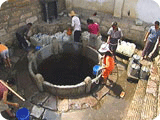Source: CCTV.com
08-02-2006 08:38

This is indeed a land of magic. Welcome to Travelogue. I am Liu Changying. This episode I will take you to one of my dream destinations in China—Yunnan province. We are here at the Honghe Hani and Yi prefecture. Honghe in Chinese means red river, a romantic name, isn’t it? Am sure after this trip, you will remember it. Together let’s explore this wonderful dreamland.

Honghe River meanders through Honghe prefecture, giving the land its name. From Kunming, capital of Yunnan province, we head south down to Jianshu and then Yuanyang. Eventually we arrive at Hekou, a border city between China and Vietnam. It’s a real journey into your fantasy.

Jianshui, our first stop. Behind me is the landmark of Jianshui, Yinghui lou. It’s one of the city gates that used to surround the city. Doesn’t it look a little bit familiar? Yeah, it does resemble Tian’anmen, of the Gate of Heavenly Peace. But here it’s called Yinghui lou.
Yinghui means “welcoming the first ray of morning sunshine”. That’s because the gate faces east, welcoming the sunrise everyday. Over 600 years ago, the local people upgraded their earthen city wall into a brick one and built four gates, including the Yinghui gate. At that time, Jianshui was still called Lin’an. Throughout the years, Yinghui gate has outlived all the other gates and the city wall, and survived a dozen earthquakes. It is said that the whole city was seriously damaged several times, while this gate managed to remain standing when I came to visit.
I think it’s fantastic to find so many swallows circling around the building. It’s their home. And I can imagine when their ancestors circled around here years and years ago, looking down at the city through their birds’ eye view, they would have seen a completely different city. Even though the city is much different today, much more modern, if you look carefully, you can still find many old traces.

All these old traces are hidden in the narrow alleyways, which have escaped the fast economic growth deep in the city. Despite the convenience of tap water, the local people still frequent the many wells that are scattered around. There is a reason that people took the effort to bring the water back home. It saves money and the water quality is quite good.
Some of the wells are so old you can find deep dents on the edges left by the ropes, which pulled up the buckets. Before the invention of plastics, the buckets were made of wood and thus could be very heavy. Imagine how much effort must have been spent here so as to leave marks deep like this.
In fact the water is so good that some people sell it for a living. One bucket for two yuan.
During all my travels, I’ve never seen a well this big. It also serves as a community center where people gather to socialize and exchange street rumors. Throughout the day people come here nonstop, and the scene almost looks like a water drawing competition.

